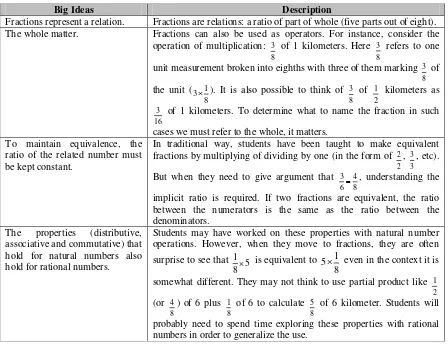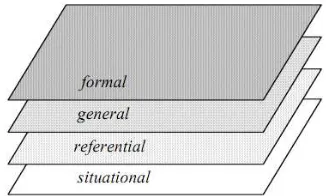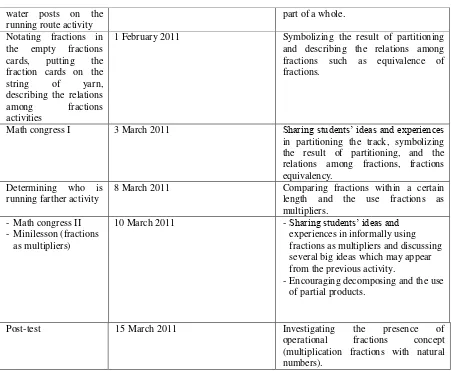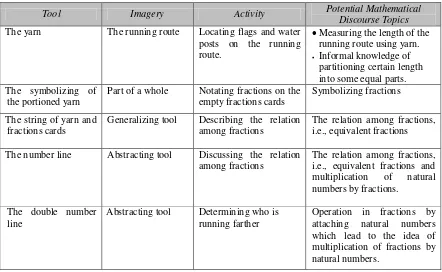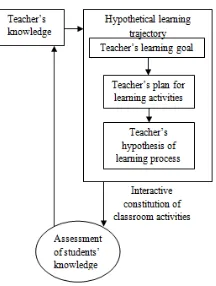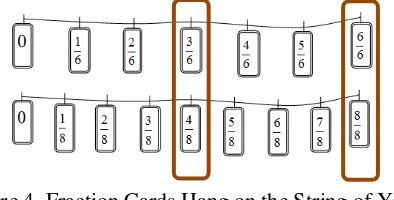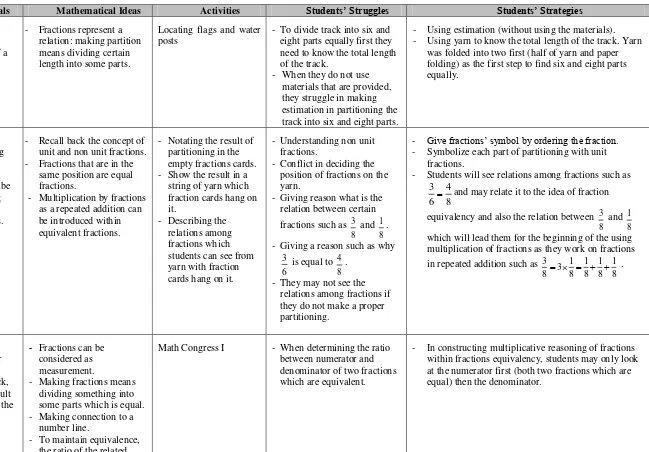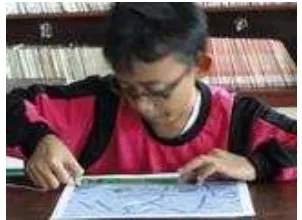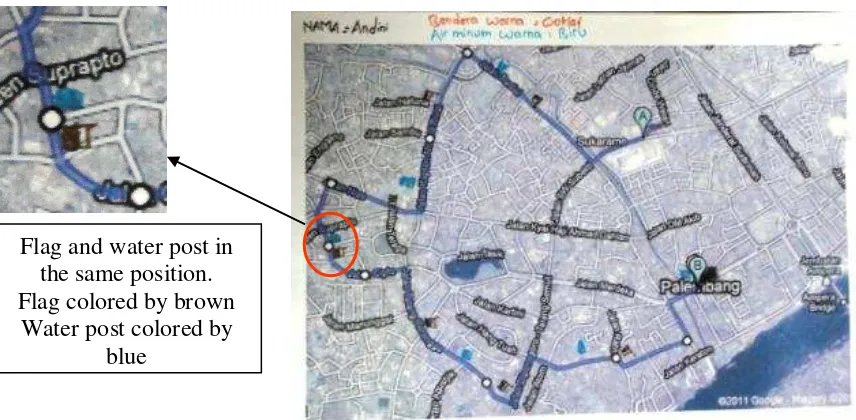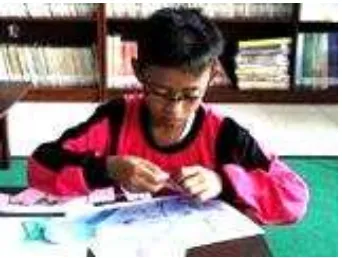INVESTIGATING THE PROGRESS OF INDONESIAN FIFTH
GR
ADE STUDENTS‟ LEARNING ON MULTIPLICATION OF
FRACTIONS WITH NATURAL NUMBERS
A THESIS
Submitted in Partial Fulfillment of the Requirements for the Degree of Master of Science (M.Sc)
in
International Master Program on Mathematics Education (IMPoME) Graduate School Sriwijaya University
(In Collaboration between Sriwijaya University and Utrecht University)
By:
Nenden Octavarulia Shanty
NIM 20092812004
GRADUATE SCHOOL
SRIWIJAYA UNIVERSITY
ii
Research Title : Design Research on Mathematics Education:
Investigating the Progress of Indonesian Fifth Grade
Students‘ Learning on Multiplication of Fractions with
Natural Numbers
Student Name : Nenden Octavarulia Shanty
Student Number : 20092812004
Study Program : Mathematics Education
Approved by :
Dr. Yusuf Hartono Dr. Ratu Ilma Indra Putri, M.Si
Supervisor I Supervisor II
Head of Director of Graduate School
Mathematics Education Department, Sriwijaya University,
Prof. Dr. Zulkardi, M.I.Komp., M.Sc. Prof. Dr. dr. H.M.T. Kamaluddin, M.Sc., SpFK. NIP 19610420 198603 1 002 NIP 19520930 198201 1 001
iii
INVESTIGATING THE PROGRESS OF INDONESIAN FIFTH
GR
ADE STUDENTS‟ LEARNING ON MULTIPLICATION OF
FRACTIONS WITH NATURAL NUMBERS
A THESIS
Submitted in Partial Fulfillment of the Requirements for the Degree of Master of Science (M.Sc)
in
International Master Program on Mathematics Education (IMPoME) Graduate School Sriwijaya University
(In Collaboration between Sriwijaya University and Utrecht University)
By:
Nenden Octavarulia Shanty NIM 20092812004
Approved by Examination Committee Signature
Dr. Yusuf Hartono
Sriwijaya University ---
Dr. Ratu Ilma Indra Putri, M.Si
Sriwijaya University ---
Dede de Haan, M.Sc.
Freudenthal Institute, Utrecht University Prof. Dr. Zulkardi, M.I.Komp., M.Sc. Sriwijaya University
---
--- Prof. Dr. R. K. Sembiring
IP-PMRI ---
Frans Van Galen, M.Sc.
Freudenthal Institute, Utrecht University --- Dr. Darmawijoyo
Sriwijaya University ---
GRADUATE SCHOOL
SRIWIJAYA UNIVERSITY
iv
I hereby:
Name : Nenden Octavarulia Shanty
Place of birth : Jakarta
Date of birth : October 30, 1984 Academic Major : Mathematics Education
State that:
1. All the data, information, analyses, and the statements in analyses and conclusions that presented in this thesis, except from reference sources are the results of my observations, researches, analyses, and views with the guidance of my supervisors.
2. The thesis that I had made is original of my mind and has never been presented and
proposed to get any other degree from Sriwijaya University or other Universities.
This statement was truly made and if in other time that found any fouls in my statement
above, I am ready to get any academic sanctions such as, cancelation of my degree that I have got through this thesis.
Palembang, May , 2011 The one with the statement
v
This study aimed at investigating the development of students‘ learning multiplication fractions with natural numbers through different levels. Therefore, design research was chosen to achieve this research goal and to contribute in formulating and developing a local instruction theory for teaching and learning of multiplication fractions with natural numbers. In design research, the Hypothetical Learning Trajectory (HLT) plays important role as a design and research instrument. It was designed in the phase of preliminary design and tested to thirty-seven students (i.e., five students in pilot experiment and thirty-two students in teaching experiment) of grade five primary school in Indonesia (i.e. SDN 179 Palembang which had been involved in Pendidikan Matematika Realistik (PMRI) or Indonesian Realistic Mathematics Education project since 2009). The designed HLT was then compared with students‘ actual learning in the experimental phase and analyzed in which students learned or did not learn from what we had conjectured them to learn in the retrospective analysis phase. The result of the experiments showed that length measurement activity could stimulate students‘ informal knowledge of partitioning in order to produce fractions as the first level in learning multiplication of fractions with natural numbers. Furthermore, strategies and tools used by the students in partitioning gradually be developed into a more formal mathematics in which the representation of yarn be used as the model of measuring situation. The representation of yarn which then called the number line could bring the students to the last activity levels, namely on the way to rules for multiplying fractions with natural numbers, and became the model for more formal reasoning. Based on these findings, it can be concluded that students‘ learning multiplication of fractions with natural numbers in which the learning process become a more progressive learning developed through different levels.
vi
Penelitian ini bertujuan untuk mengkaji kemajuan belajar siswa pada materi perkalian pecahan dengan bilangan bulat melalui berbagai tingkatan yang berbeda-beda. Oleh karena itu, design research dipilih untuk mencapai tujuan penelitian dan untuk berkontribusi dalam merumuskan dan mengembangkan teori instruksi lokal dalam pembelajaran perkalian pecahan dengan bilangan bulat. Dalam design research, lintasan belajar (Hypothetical Learning Trajectory) memegang peranan penting sebagai desain dan instrumen penelitian. Lintasan belajar dirancang dalam tahap desain awal dan diujikan pada 37 siswa (yaitu, 5 siswa pada percobaan kelompok kecil dan 32 siswa pada percobaan kelas) kelas lima di Indonesia (yaitu, SDN 179 Palembang yang telah terlibat dalam proyek Pendidikan Matematika Realistik Indonesia (PMRI) sejak tahun 2009). Lintasan belajar yang telah dirancang kemudian dibandingkan dengan pembelajaran siswa sebenarnya pada tahap percobaan dan dianalisis dimana siswa belajar atau tidak belajar dari apa yang telah kita duga mereka untuk belajar pada tahap analisis retrospektif. Hasil penelitian menunjukkan bahwa aktivitas pengukuran panjang dapat menstimulasi pengetahuan informal siswa dalam mempartisi untuk menghasilkan pecahan sebagai level pertama dalam tahapan pembelajaran perkalian pecahan dengan bilangan bulat. Selanjutnya, strategi-strategi dan alat yang digunakan oleh siswa dalam mempartisi secara bertahap dikembangkan menjadi matematika yang lebih formal dimana garis bilangan digunakan sebagai model of situasi pengukuran. Representasi dari benang yang kemudian disebut garis bilangan dapat membawa siswa menuju tingkat aktivitas akhir, yaitu dalam perjalanan menuju aturan perkalian pecahan dengan bilangan bulat, dan menjadi model for penalaran yang lebih formal. Berdasarkan temuan-temuan yang didapatkan, dapat disimpulkan bahwa pembelajaran siswa mengenai materi perkalian pecahan dengan bilangan bulat dimana proses belajar lebih progresif berkembang melalui tingkatan yang berbeda-beda.
vii
The domain of skill and knowledge referred to as "fractions" has been parsed in various ways by researchers in recent years. Focus on this study, an important developmental step in learning multiplication of fractions with natural numbers is the transition of counting principles from multiplying natural numbers to multiplying fractions. To scaffold this transition, we tried to design a sequence of activities in which length measurement activity be used as a starting point in teaching and learning process.
This study aimed at investigating the development of students‘ learning of multiplication fractions with natural numbers through different levels. In the design research, the Hypothetical Learning Trajectory (HLT) served as a design and research instrument. This HLT was tested to thirty-seven students of fifth grade (i.e. SDN 179 Palembang which had been involved in the Pendidikan Matematika Realistik (PMRI) or Indonesian Realistic Mathematics Education project since 2009) through two cycles, namely pilot and teaching experiments. The pilot experiment was conducted in the first two weeks to five students, excluded from teaching experiment class. Based on the observations in the pilot experiment, initial HLT was then improved and adjusted to be used in the real teaching experiment.
The sequence of activities in our HLT was designed based on levels which preceded the learning operation of fractions. Therefore, in this summary, we will describe a brief result of our research based on those levels.
1. Producing Fractions
To produce fractions, the students worked on the first and the second activity. Through
‗locating eight flags and six water posts‘ activity, it was found that length measurement activity could bring the students to perceive the idea of partitioning a certain length fractions (e.g the relation between 1
8
-jumps with point 5 8
). In this activity, the students came to the drawing a representation of yarn used to measure the length of running route as a model of measuring situation. This representation was then called number line of fractions in which fractions appeared on the number line. Through the number
line, students‘ knowledge about equivalent fractions which can be seen from fractions
on the same position was explored well. The students could also grasp the idea of
‗jumps‘ which then led them to the idea of multiplication of natural numbers by fractions as repeated addition of fractions. They found out that there were five times 1
viii 3. Operating through Mediating Quantity
By attaching the length of the route in the activity of „determining who is running farther‟, the students were able to find 5
8 of 6 kilometers and
4
6 of 6 kilometers. The length of running route served as a mediator to lead the idea of fractions as operator. In this activity, double number line model appeared as a model connected to the activity of partitioning the yarn (activity 1). Besides, there was a surprising idea from some students in working group session who could find the answer of 4
6 of 6 kilometers by only multiplying the length with the numerator of fraction then put the denominator bellow the result. They came up with the rule of operation with fraction when they saw the connection between 5 1
8
with 5 8.
4. Doing One‟s Own Production
At this level, progression meant that the students were able to solve problems in a more and more refined manner at the symbolic level. As mentioned in the third tenet of RME, the biggest contributions to the learning process were coming from student's own creations and contributions which led them from their own informal to the more standard formal methods. The group who found the rule of operation with fraction had made a significant contribution to the classroom community for the idea of multiplying fractions by natural numbers. However, there were some students who still used the double number line to solve the problem of multiplication fractions by natural number. It means that the double number line model still made sense for those students.
5. On the Way to Rules for the Operations with Fractions
In the formal level, students‘ reasoning with conventional symbolizations started to be
independent from the support of models for mathematical activity. The transition to a more formal operation with fractions was preceded by stimulating students to contribute their own informal ways of working which led by the group who found the rule of multiplying fractions by natural numbers. At this level, it was shown that
students‘ contribution became model for more formal reasoning and the general level of modeling had been attained by the students.
Based on the findings, it can be concluded that the use of length measurement context has stimulated students to start the first activity level in learning multiplication of fractions with natural numbers. It was started from producing their own fractions until on the way to rules for multiplying fractions with natural numbers. The emergence of model supports
students‘ transition from concrete situational problems to a more formal and general
ix
Domain dari keterampilan dan pengetahuan tentang ―pecahan‖ telah dipaparkan dengan berbagai cara oleh para peneliti dalam beberapa tahun terakhir. Fokus pada studi ini, langkah penting dalam perkembangan belajar perkalian pecahan dengan bilangan bulat adalah pada masa transisi prinsip perhitungan dari mengalikan bilangan bulat ke mengalikan pecahan. Untuk menjembatani masa transisi ini, kami mencoba untuk merancang suatu urutan kegiatan dimana aktivitas pengukuran panjang digunakan sebagai titik awal dalam proses belajar mengajar.
Penelitian ini bertujuan untuk mengkaji kemajuan belajar siswa pada materi perkalian pecahan dengan bilangan bulat melalui tingkatan yang berbeda-beda. Dalam design research, lintasan belajar (Hypothetical Learning Trajectory) berfungsi sebagai desain dan instrumen penelitian. Lintasan belajar ini kemudian diujicobakan pada 37 siswa kelas lima (yaitu, SDN 179 Palembang) melalui dua siklus, yaitu percobaan kelompok kecil dan percobaan kelas. Percobaan kelompok kecil dilakukan dalam dua minggu pertama pada lima siswa dimana siswa tersebut tidak termasuk dalam percobaan kelas. Berdasarkan pengamatan dalam percobaan kelompok kecil, lintasan belajar awal kemudian diperbaiki dan disesuaikan untuk kemudian digunakan dalam percobaan kelas.
Urutan kegiatan belajar dirancang berdasarkan tingkatan-tingkatan dalam membelajarkan operasi hitung pada pecahan. Oleh karena itu, dalam ringkasan ini, kami akan menjelaskan secara singkat hasil penelitian kami berdasarkan tingkatan-tingkatan tersebut.
1. Menghasilkan Pecahan
Untuk menghasilkan pecahan, siswa mengerjakan aktivitas satu dan dua. Melalui
aktivitas ‗menempatkan delapan bendera dan enam stan air minum‘, ditemukan bahwa aktivitas pengukuran panjang dapat menggiring siswa menuju ide mempartisi suatu panjang tertentu menjadi beberapa bagian sama panjang. Kegiatan kemudian dilanjutkan dengan menuliskan bentuk pecahan untuk setiap bagian hasil partisi. Dalam aktivitas ini, pengetahuan siswa mengenai arti pecahan sebagai bagian dari keseluruhan
diperlukan. Hasilnya, siswa dapat menghasilkan pecahan, yaitu unit pecahan
Pada aktivitas kedua, siswa juga diminta untuk menggambarkan hubungan antara pecahan (sebagai contoh, hubungan antara lompatan 1
8 dengan titik
5 8
x
3. Melakukan Operasi Hitung melalui Mediasi Kuantitas
Dengan melibatkan panjang lintasan lari pada aktivitas ―menentukan siapa yang lari lebih jauh‖, siswa mampu menemukan jawaban 5
8 dari 6 kilometer dan 4
6 dari 6 kilometers. Panjang lintasan lari berfungsi sebagai perantara untuk menuju ke ide
pecahan sebagai operator. Pada aktivitas ini, garis bilangan ganda muncul sebagai sebuah model berkaitan dengan aktivitas mempartisi benang (aktivitas 1). Selain itu, ditemukan sebuah ide dari sekelompok siswa yang dapat menemukan jawaban 4
6 dari 6 kilometer dengan hanya mengalikan panjang lintasan lari dengan pembilang pecahan dan kemudian menyimpan penyebut pecahan dibawah hasil perkalian tersebut. Mereka memiliki ide aturan operasi pada pecahan ketika melihat hubungan 5 1
8
dengan 5 8.
4. Melakukan Produksi Sendiri
Pada level ini, suatu perkembangan diartikan ketika siswa mampu memecahkan masalah dengan cara yang lebih ke arah simbolis. Seperti disebutkan pada prinsip ketiga pendekatan RME (Realistic Mathematics Education), kontribusi terbesar dalam proses belajar berasal dari kreasi dan kontribusi siswa sendiri yang kemudian menggiring mereka dari informal menuju ke arah yang lebih formal. Kelompok yang menemukan aturan operasi pada pecahan memberikan kontribusi yang sangat signifikan pada komunitas kelas mengenai ide perkalian pecahan dengan bilangan bulat. Namun, ada beberapa siswa yang masih menggunakan garis bilangan ganda untuk menyelesaikan masalah berkaitan dengan perkalian pecahan dengan bilangan bulat. Hal ini dimungkinkan karena penggunaan garis bilangan ganda masih melekat pada siswa tersebut.
5. Dalam Perjalanan Menuju Aturan Operasi pada Pecahan
Pada tingkat formal, penalaran siswa menggunakan simbol konvensional mulai lepas dari dukungan model untuk aktivitas matematika. Transisi untuk ke arah operasi yang lebih formal diawali dengan menstimulasi siswa untuk berkontribusi pada cara bekerja informal mereka sendiri yang kemudian menggiring suatu kelompok untuk menemukan aturan perkalian pecahan dengan bilangan bulat. Level ini menunjukkan bahwa kontribusi siswa menjadi model untuk penalaran yang lebih formal dan tingkat umum pemodelan telah dicapai oleh siswa.
xi
Experience is not what happens to you. It is what you do with what happens to you. Many people contributed to my development. Therefore, to what is set down in this thesis,
I thank them all for helping me to write this thesis; supervisors, colleagues, teachers and students who involved in this research, and many others.
Experiments reported in this thesis were conducted at SDN (Sekolah Dasar
Negeri/State Primary School) 179 Palembang which had been involved in the Pendidikan Matematika Realistik (PMRI) or Indonesian Realistic Mathematics Education project since
2009. This school offered me the chance to work with their students. The school‘s headmistress and teachers helped me in many ways to conduct the study reported upon
here. I owe them my gratitude for the flexibility they expressed in sharing their school.
I especially thank Dra. Yuliani, M.M., the school‘s headmistress, and Mrs. Sri Horestiati, teacher who involved in this research, for their support.
Discussions with my supervisors Dr. Yusuf Hartono and Dr. Ratu Ilma Indra Putri, M.Si at Sriwijaya University and Dede de Haan at Freudenthal Institute finally made that
this study got its present form. I thank them for their guidance, for their willing ear and sharp remarks. I enjoyed all their guidance and am grateful for the support it gave me to finally finish this thesis.
I also thank to Prof. Dr. dr. H.M.T. Kamaluddin, M.Sc., SpFK., as the director of
Graduate School Sriwijaya University, Prof. Dr. Zulkardi, M.I.Komp., M.Sc., as the head of Mathematics Education Department in Graduate School Sriwijaya University, lecturers
and staffs in Sriwijaya University: Dr. Darmawijoyo, Dr. Somakim, Aliwandi, Tesi, lecturers and staffs in Freudenthal Institute, Utrecht University: Jan van Maanen, Jaap den Hertog, Barbara Ann van Amerom, Frans van Galen, Dolly van Eerde, Martin Kindt, Jo
xii
Dra. Pinta D. Sampoerno, M.Si., Drs. Swida Purwanto, M.Pd., Drs. Anton Noornia, M.Pd.,
Dra. Marheni, M.Sc., Drs. Amos Kandola, M.Pd., Directorate General of Higher Education (DIKTI) and Nuffic NESO (Netherlands Education Support Office) who also support the
funds for the scholarship of my master education, thank you for all your support. I, moreover, thank Bart Bookelmann for the help of correcting English in this thesis, thank
you for being such a nice friend for me.
Finally, all this work also had its impact on the home front.
There, Yanti Muslihah, who I love so much, my very excellent mother, had to let her
daughter to go abroad about 11.000 kilometers very far away from family to a ‗Van
Orange‘ country for a year and a year in Palembang, and also, Denny and Nandang, my
xiii
List of Appendices ...xviii
Chapter 1. Introduction ... 1
Chapter 2. Theoretical Framework ... 4
A. Fractions as Magnitude ... 4
B. Multiplication by Fractions ... 5
C. Realistic Mathematics Education (RME) ... 10
1. Five Tenets of RME ... 10
2. Emergent Modeling ... 12
D. Multiplication by Fractions in the Indonesian Curriculum for Primary school ... 14
Chapter 3. Research Methodology ... 16
A. Design Research ... 16
B. Research Subject and Timeline ... 18
C. Data Collection ... 19
D. Data Analysis ... 20
E. Validity and Reliability ... 21
Chapter 4. Local Instruction Theory ... 24
A. The Goals ... 24
1. The Research Goal and the Research Questions ... 24
2. The Learning Goals for Students ... 25
B. Conjectures about Possible (Mathematical Learning Processes) ... 26
C. Conjectures about Possible Means of Supporting that Learning Process ... 27
D. Hypothetical Learning Trajectory (HLT) ... 29
1. The Learning Activities ... 29
2. Visualization of Learning Lines of Multiplication Fractions with Natural Numbers ... 49
Chapter 5. Retrospective Analysis ... 50
A. Pilot Experiment ... 50
1. Pre-Assessment ... 50
2. Activity 1: Locating Flags and Water Posts on the Running Route (Worksheet 1) ... 52
3. Repetition of Activity 1: Locating Flags and Water Posts on the Running Route ... 55
4. Activity 2: Notating Fractions on the Empty Cards, Putting the Cards on the String of Yarn, Describing the Relations Among Fractions ... 56
5. Activity 3: Math Congress 1 ... 59
6. Activity 4: Determining Who is Running Farther ... 63
7. Activity 5: Math Congress 2 ... 66
xiv
B. Teaching Experiment... 70
1. Pre-Assessment of Students‘ Knowledge ... 71
2. Producing Fractions ... 76
a. Locating Flags and Water Posts on the Running Route and Its Contribution in Supporting Students‘ Acquisition of the Concept of Partitioning a Certain Length ... 77
b. Notating Fractions in the Empty Fractions Cards to Produce Fractions ... 80
3. Generating Equivalencies ... 83
a. The Number Line Model as a Bridge from Situational Knowledge to More Formal Knowledge about Fractions ... 83
b. Math Congress 1: Communicating and Developing Ideas about Fractions on the Number Line ... 85
c. Introducing the Concept of Multiplication as Repeated Addition by Using Jumping on the Number Line of Fractions ... 88
4. Operating through Mediating Quantity ... 91
a. The activity of ‗Determining Who is Running Farther‘ as the Beginning of the Involvement of Fractions as Operator ... 91
5. Doing One‘s Own Production ... 99
a. Math Congress 2: Communicating and Developing Ideas... 99
6. On the Way to Rules for the Operation with Fractions ... 102
7. The Post-Assessment of Students‘ Learning Operation with Fractions ... 106
Chapter 6. Conclusions and Discussions... 115
A. Conclusion ... 115
B. Recommendations ... 116
References ... 118
Appendices ... 121
xv
Table 1. The Big Ideas of Multiplication With Fractions that Are
Formulated by Fosnot & Hellman (2007) ... 8
Table 2. The Strategies of Multiplication with Fractions that are Formulated by Fosnot & Helman (2007) ... 9
Table 3. Fractions for Primary School Grade Five in the Second Semester in Indonesian Curriculum ... 14
Table 4. The Timeline of the Research ... 18
Table 5. The Description of Data Collections ... 19
Table 6. Tools and Imagery of the Learning Activity... 27
Table 7. Sequence of Activities of Multiplication Fractions with Natural Numbers ... 47
xvi
Figure 1. Levels of Mathematical Activity ... 13
Figure 2. Hypothetical Learning Trajectory (Simon, 1995) ... 29
Figure 3. Running Route ... 32
Figure 8. From Left to Right: Andini, Oriang, Zulfa, Fachrie, And Ghalda Tried to Map the Yarn Following the Running Track ... 53
Figure 9. Fachrie Tried to Measure the Total Length of the Route ... 53
Figure 10. Zulfa Folded Her Yarn then Gave Marks on It ... 53
Figure 11. One of Student‘s Worksheet in Locating Flags and Water Posts in the Running Route ... 56
Figure 12. Fachrie Tried to Put Fractions Cards on the Marks ... 57
Figure 13. Ghalda Using Unit Fractions ... 57
Figure 14. Andini Using Non Unit Fractions ... 57
Figure 15. Andini with Her Fractions Cards Hanging on the Yarn ... 58
Figure 16. Zulfa‘s Representation of Yarn and the Fractions Cards ... 61
Figure 17. Andini‘s Representation of Yarn and the Fractions Cards ... 61
Figure 18. Fachrie‘s and Oriang‘s Answer about Fractions in the Same Position ... 61
Figure 19. Fachrie‘s Tried to Simplify Fractions ... 61
Figure 20. Fachrie‘s Idea of ‗Jumps‘ ... 63
Figure 21. Andini‘s Work Using the Double Number Line Strategy ... 65
Figure 22. Fachrie‘s Idea of Proportional Reasoning ... 66
Figure 23. Ghalda‘s Story Problem ... 67
Figure 24. Ghalda‘s Answer of Problem Number 1 ... 68
Figure 25. Ghalda‘s Answer about Multiplication of Fractions in Worksheet 6 ... 69
Figure 26. Some Examples of Students‘ Answers in Partitioning Pempek Lenjer into Four and Three Parts Equally ... 72
Figure 27. Dinda‘s Strategy In Partitioning Pempek Into Four And Three Parts Equally by Using Ruler ... 73
Figure 28. Natasya‘s Equivalent Fractions... 74
Figure 29. Reza‘s Answer about Ordering Fractions from Greatest to Least ... 75
Figure 30. Natasya‘s Answer about Operation Which Involved Fractions... 75
Figure 31. Students Work Together to Map the Yarn on the Running Route ... 77
Figure 32. Students Measured the Shortest Distance from Point A to B ... 78
xvii
Figure 35. Students Remapped the Yarn Back to Give Position of the Flags ... 80
Figure 36. Students Fraction‘s Notation Using Unit Fractions ... 81
Figure 37. Students Hung Their Non-Unit Fraction Cards on The Yarn ... 81
Figure 38. One of Students‘ Works of Activity 1 and 2 ... 82
Figure 39. One of Students‘ Drawings as a Representation of Yarn and Fraction Cards ... 84
Figure 40. One Of Students‘ Findings From Their Drawing Of Yarn And Fraction Cards ... 85
Figure 41. Two Groups Presented Their Drawings on the Board ... 86
Figure 42. From Left to Right: Beladas‘s and Kucing‘s Drawings of Yarn and Fraction Cards ... 86
Figure 43. Students‘ Arguments about the Differences of Beladas‘s and Kucing‘s Drawing of Yarn ... 87
Figure 44. Tirta‘s Idea about Simplification Of Fractions ... 87
Figure 45. Ari‘s Thinking about ‗Jumps‘ ... 89
Figure 46. Ihsan‘s Thought about the Relation Between Addition of Fractions with Multiplication of Fractions ... 89
Figure 47. Teacher Tried to Introduce the Use of Double Number Line ... 92
Figure 48. Kucing Group‘s Strategy about a Half of a Half of the Whole ... 94
Figure 49. Students‘ Way in Dividing 11 2 by Two ... 94
Figure 50. Beladas Group‘s Idea about Finding the Length of 1 8 ... 95
Figure 51. Student‘s Answer of the Problem 5 8 of 6 Kilometers ... 96
Figure 52. Another Way to Find 5 8 of 6 Kilometers ... 96
Figure 53. Spenta Mania Group in Solving the Problem of 4 6 of 6 Kilometers ... 96
Figure 54. Singa Mania And Spenta Mania Strategy In Finding The Distance Of Ari . 100 Figure 55. Nanda‘s Word Problem on the String Number in Mini Lesson ... 102
Figure 56. Rio‘s Strategy in Mini Lesson ... 103
Figure 57. Jessica‘s Strategy in Mini Lesson ... 103
Figure 58. Dhea‘s Work in Partitioning Rope ... 107
Figure 59. Dinda‘s Work of Partitioning the Rope and Finding Fractions in the Same Position ... 107
Figure 60. Tri‘s Work in Finding Fractions in the Same Position ... 108
Figure 61. Jessica‘s Answer about the Relation between Fractions 1 10 and 5 10 ... 109
Figure 62. Nanda‘s Answers about Multiplication Fractions with Natural Numbers ... 110
xviii
Appendix 1. Running Route ... 121
Appendix 2. Pre-test ... 122
Appendix 3. Post-test ... 124
Appendix 4. Lesson Plans ... 127
CHAPTER 1
INTRODUCTION
Researches have identified major problems with current learning methods for
teaching fractions. The first dealt with a syntactic (rules) rather than semantic (meaning) emphasis of learning rational numbers, where the learning processes often emphasize technical procedures in doing fraction operations at the expense of developing a strong
sense in students of the meaning of rational numbers (Moss & Case, 1999). This problem leads to algorithmically-based mistakes, which result when an algorithm is viewed as a
meaningless series of steps so that students often forget some of these steps or change them in ways that lead to errors (Freiman & Volkov, 2004).
In learning multiplication by fractions in Indonesia, most of the students are required
to master the procedures and algorithms. They just need to memorize formulas and tricks in calculation to solve the problems. However, we do not know whether the students know
and understand the meaning of the procedures and algorithms lay behind it. Even we ourselves never fully understand why we need to multiply the numerator and the
denominator together to multiply two fractions until now. As stated in P4TK (Pusat Pengembangan Pemberdayaan Pendidik dan Tenaga Kependidikan), teachers who play a crucial role in the mathematical learning outcomes of their students still have weaknesses
in mastering the material, the preparation, use of media, as well as the selection of strategies/methods in teaching topic about multiplication by fractions (P4TK, 2009). Most
students know how to apply the procedure without understanding why the procedure works (de Castro, 2004).
Secondly, the learning processes often takes an adult-centered rather than a
taking into consideration schema and informal knowledge of fractions, thus denying
students a spontaneous means of learning fractions (Moss & Case, 1999). One of the reasons points out as to why the mathematical notion of fractions is systematically
misinterpreted because fractions are not consistent with the counting principles that apply to natural numbers to which students often relate (Stafylidou & Vosniadou, 2004). Focus on the multiplication in counting principles, in multiplying natural numbers, the product is
larger than the factor. On the other hand, in multiplying fractions, the product may either be higher or lower than the factors. The fact that multiplication by fractions does not
increase the value of the product might confuse those who remember the definition of multiplication presented earlier for natural numbers.
Considering the two aforementioned issues, it seems to be necessary to remodel
mathematics teaching and learning, especially in domain multiplication fractions with natural numbers. Therefore, we conducted a design research that developed a sequence of
activities emphasizing on a shift from ―mastering procedures‖ to ―understanding‖. In
proposing this design research we referred to Realistic Mathematics Education (RME) that
has been developed in the Netherlands since in early 1970s. This method is based on the idea of mathematics as a human activity and as a constructive activity.
According to Streefland (1991), there are five levels in learning operation with
fractions, namely producing fractions, generating equivalencies, operating through mediating quantity, doing one‘s own productions and on the way to rules for the operations with fractions. In this study, we follow Streefland by promoting problem on the context at any stage. We proposed the use length measurement as the contextual situation of the
activities to support students‘ learning. The context of running route was used as a starting
related to fractions and natural numbers. The aim of the research was to investigate the
development of students‘ learning of multiplication fractions with natural numbers through different levels. Therefore, the research question was formulated as follows.
“How does students‟ learning of multiplication fractions with natural numbers develop
through different levels?”
In this study, we tried to focus the issues concerning the development of students‘ learning of multiplication fractions with natural numbers through different levels. Therefore, we attempted to answer sub-research questions:
1. How does the length measurement activity with the help of yarn provoke students in
producing their own fractions?
2. How does the string of yarn lead the students to the idea of number line?
3. How does a number line lead the students to the idea of multiplication of natural
numbers by fractions by generating equivalencies?
4. How does the involvement of certain length as the mediating quantity lead the
students to the idea of multiplication of fractions by natural numbers?
5. How does student‟s own production about the idea of multiplication of fractions
CHAPTER 2
THEORETICAL FRAMEWORK
This chapter provides the framework of thinking used in this study. Literatures about fraction as magnitude and multiplication by fractions were studied to design the
instructional activities of multiplication fractions with natural numbers.
In this research, length measurement activity was used as a starting point and
contextual situations to investigate the development of students‘ learning multiplication fractions with natural numbers. To explain and investigate how the framework of learning
multiplication of fractions with natural numbers in the measurement activity bring the students to the more formal mathematics, we also discussed about the Realistic Mathematics Education approach.
Because the research conducted in Indonesia, this chapter also provides an overview about multiplication by fractions for elementary school in Indonesian curriculum.
A. Fraction as Magnitude
Early fractions instruction generally focuses on the idea that fractions represent parts
of a whole (e.g., one-third as the relation of one part to a whole that has three equal parts). Although the part-whole interpretation of fractions is important, too often instructions do
not convey another simple but critical idea: fractions are numbers with magnitudes (values).
In the mathematics point of view, magnitude means the quantity of the objects.
Freudenthal (1983) defined magnitude as the mathematical model that fits the mathematical distribution problem. For instance, the mathematical distribution problem is
phenomenological approach we must start with the objects in which equivalence relation
can form classes representing the magnitude of values.
Freudenthal also defined four requirements to describe the magnitude in a system of
quantities. We selected two of the requirements which relate to multiplication by fractions, namely:
1. An equivalent relation which describes the conditions for replacing objects. For
instance, quantities of a certain substance, with each other and which lead to the equality within the magnitude.
2. The possibility of dividing an object into an arbitrary number of partial objects that replaced each other, which led to division by natural number.
Connected with multiplication by natural number, Freudenthal (1983) defined
multiplication by natural numbers as a repeated addition: ―nth part of‖ becomes the inverse of ―n times‖. By composing multiplications and divisions with each other we came to the
mathematical idea of multiplications by fractions.
B. Multiplication by Fractions
Streefland (1991) suggested five activity levels in learning operation with fractions, namely producing fractions, generating equivalencies, operating through mediating
quantity, doing one‘s own productions and on the way to rules for the operations with
fractions. In this sub chapter, we focused on the five activity levels that are offered by Streefland, more specific to our main domain which is multiplication by fractions. The
levels are described as follows.
1. Producing fractions.
varied distribution. Divergent contexts and processes are explored which could produce
fractions, such as fair sharing, division, length measurement, making mixtures, combining and applying recipes. By linking to the involved magnitudes and varying the objects, the
notion of a fraction in operator became clear. For instance, a certain condition, when applies to partition a certain length, will naturally cause a variety of solutions with accompanying notations of fractions.
2. Generating equivalencies.
After students has experienced with notating fractions of their own fractions production, the learning process will continue to generate equivalencies as students are
asked to determine fractions in the same position. Equivalencies occur when the distribution problem is given, for instance, the case of partitioning a certain length into eight parts. The equivalencies may occur when students were asked about the relation
between 5 8 and
1 8.
The multiplicative reasoning of fractions within fractions equivalency also refers to
two definitions, namely fractions involve between – and within – multiplicative relations (Vanhille & Baroody, 2002). Between-multiplicative relation refers to the relation between the numerators and the denominators of equivalent fractions. If two fractions are
equivalent, the ratio between the numerators is the same as the ratio between the denominators. Within-multiplicative relation refers to the relation between the numerator
and the denominator of a fraction. For example, in 3
4 the numerator, 3, is 3
4 of the
denominator 4 (i.e., 3 3 4 4
); and the denominator, 4, is 4
3 of 3 (i.e., 4
4 3
3
). All
3. Operating through mediating quantity.
To lead to the idea of fractions as operator, we can involve the length to a given unit. The fraction which at the first is described as part of a whole relationship now become a
fraction in an operator. Based on Fosnot and Dolk (2002), this concept is important because it will connect to the idea of double number line. Taber (1992) suggested that instruction of multiplication with fractions shall relate to multiplication with natural
numbers while reconceptualizing students‘ understanding of natural numbers multiplication to include fractions as multipliers.
4. Doing one‟s own productions.
At this moment, we cannot put high expectation that the students will come up with their own production. Therefore, questions which can provoke them are needed at this level. Multiplication strategies for fractions can be built upon this equivalence. For
instance, the decompositions of 5
8, can be carried out in with the aid of unit by unit division, which is in the meantime becoming a more standard procedure:
5 1 1 1 1 1 1
5
8 8 8 8 8 8 8. At this moment, students can also explore multiplication fractions as repeated addition. Connected with the third level, when natural number
involves in the multiplication fractions, the use of fractions as multipliers is important. For instance, when students are asked to find five-eighth of 6 kilometers which can be written
in more formal mathematics as 5 6
8 . At this level, progression means that the students are able to solve problems in a more and more refined manner at the symbolic level.
5. On the way to rules for the operations with fractions.
Within mini lesson which include fractions as multipliers, the students reflect on the rules for the multiplication by fractions operations which may be in force here. The
transition to more formal fractions is preceded by stimulating students to contribute their own informal ways of working. Therefore, in the mini lesson, it is possible to bring about this transition to application of more formal rules.
The five activity levels above are built upon a set of big ideas and strategies
underlying multiplication with fractions which are described in the following table.
Table 1. The Big Ideas of Multiplication with Fractions that are Formulated by Fosnot & Hellman (2007)
Big Ideas Description
Fractions represent a relation. Fractions are relations: a ratio of part of whole (five parts out of eight). The whole matter. Fractions can also be used as operators. For instance, consider the
operation of multiplication: 3 8
of 1 kilometers. Here 3 8
refers to one
unit measurement broken into eighths with three of them marking 3 8
cases we must refer to the whole, it matters. To maintain equivalence, the
ratio of the related number must be kept constant.
In traditional way, students have been taught to make equivalent fractions by multiplying of dividing by one (in the form of 2
2
The properties (distributive, associative and commutative) that
As students work with the five activity levels, we notice that students may use many
strategies for multiplication by fractions. The strategies to notice are described in the following table.
Table 2. The Strategies of Multiplication with Fractions that are Formulated by Fosnot & Hellman (2007)
Using multiplication and division to make equivalent relations. denominator and multiply by the numerator.
Using landmark fractions to make partial products.
Calculating 5 8
of 6 kilometer can be simple if students think about
to use landmark fractions. A half of 6 is 3, then the students only need to think 1
8
of 6 and add the two partial products together. The
distributive property for multiplication over addition underlies this strategy.
proportional reasoning and an understanding of the relationship involved.
Using the standard algorithm for multiplication of fractions.
Multiply the numerators and the denominators together. This standard algorithm can be quickly understood when the array model is used.
For instance, 3 2
53
is shown in the model below. The product is 6
15
.
The outer rectangle is formed by the denominators (5 3 ), and the inner rectangle is formed by the numerators (3 2 ).
The use of array model as a strategy to solve multiplication by fractions which is
multiplication of fractions by fractions. However, this study only focused on multiplication
fractions with natural numbers. Therefore, we did not discuss the use of array model at this present study.
C. Realistic Mathematics Education (RME)
Realistic Mathematics Education (RME) is a theory of mathematics education which
has been developed in the Netherlands since 1970s. This theory is strongly influenced by
Hans Freudenthal‘s concept of ‗mathematics as a human activity‘ (Freudenthal, 1991).
According to Freudenthal, students should not be treated as passive recipients of ready-made mathematics, but rather than education should guide the students towards using opportunities to discover and reinvent mathematics by doing it themselves. Therefore, this
study developed a sequence of instructional activities on multiplication fractions with natural numbers in which the students understand the problem instead of mastering the
procedures and algorithms. To shift from the situational activities to the more formal mathematics, the tenets of Realistic Mathematics Educations (RME) offered clues and design heuristics.
1. Five Tenets of RME
The process of designing a sequence of instructional activities that started with contextual situation in this study is inspired by five tenets in Realistic Mathematics
Education as a combination of Van Hiele‘s three levels, Freudenthal‘s didactical phenomenology and Treffer‘s progressive mathematization (Treffers, 1991). The
1. The use of contextual problems.
Contextual problems figure as applications and as starting points from which the intended mathematics can come out. The mathematical activity is not started from a formal
level as students usually face with, but from a situation that is experientially real for students. Consequently, this study used the running race route as the context in which the students could act and reason to the given problems.
2. The use of models or bridging by vertical instruments.
Broad attention is paid to the development models, schemas and symbolizations rather than being offered the rule or formal mathematics right away. Students‘ informal
knowledge as a result of students‘ experience in making partitioning using tools (i.e., yarn)
needed to be developed into formal knowledge of fractions which would lead to the idea of equivalent fractions when the notation of the result of partitioning were put on the string of
yarn. The use of string of yarn here was as a bridge to the number line model which was in more abstract level.
3. The use of students‟ own creations and contributions.
The biggest contributions to the learning process are coming from student's own
constructions which lead them from their own informal to the more standard formal methods. Students‘ strategies and solutions can be used to develop the next learning process. The use of string of yarn served as the base of the emergence model of number line.
4. The interactive character of the teaching process or interactivity.
The explicit negotiation, intervention, discussion, cooperation and evaluation among students and teachers are essential elements in a constructive learning process in which the
running race problems in each day which were designed in continuity story, students could
communicate their works and thoughts in the social interaction emerging in the classroom.
5. The intertwining of various mathematics strands or units.
From the beginning of the learning process, the learning activities of fractions are intertwined with proportion. This means that explanation of the unifying relationship
between, for instance, equivalent fractions and proportion was not kept until the very end of the learning process. Moreover, learning multiplication by fractions through length
measurement activity would also support the development of students‘ skills and ability in the domain of geometry.
2. Emergent Modeling
Gravemeijer suggested that instead of trying to help students to make connections with ready-made mathematics, we should try to help students construe mathematics in a more
bottom-up manner (Gravemeijer, 1999, 2004). This recommendation fits with the idea of emergent modeling. Modeling in this conception is an activity of the students.
Initially, the models refer to concrete situations, which are experientially real for the students. When the students have more experience with similar problems, their attention
may shift towards the mathematical relations and strategies. As a consequence, the model becomes more important as a base for mathematical reasoning than as a way to solve the problem. In this situation, the model started to become a referential base for the level of
formal mathematics. Or in short, a model of informal mathematical activity develops into a model for more formal mathematical reasoning.
Figure 1. Levels of mathematical activity
The implementation of the four general types of activities in this study is described as follows.
(1) Situational activity, in which interpretations and solutions depend on the understanding of how to act and to reason in the setting. The setting in this present
study was the context of running race route. In this level, through the problem of
―locating flags and water posts on the running route‖, students would explore their
informal knowledge of partitioning when they were asked to divide a certain length
into some equal parts.
(2) Referential activity, in which model of refer to activity in the setting described in
instructional activities. Students‘ activities might be considered referential when they
were initially use tools (yarn) as a representation of running race route. In this study, the activity of ―notating fractions in the empty fractions cards and putting fractions cards on the string of yarn‖ also served as referential activity in which students produced their own fractions to represent their way in making construction of
partitioning. In this activity, the representation of string of yarn became the model of measuring situation.
(3) General activity, in which model for refer to a framework of mathematical relations.
Students were asked to describe the relation among fractions which they could see
from their own fractions production. In addition, the activity of ―determining who is
running farther‖ which the length of the running race route was involved would lead students to the idea of fractions as operator. At this moment, the double number line could be used as a helpful tool to find the distance that could be covered by two runners where their locations were known with the help of flags and water posts.
(4) Formal mathematical reasoning which is no longer dependent on the support of models for mathematical activity. The focus of the discussion moves to more specific
characteristics of models related to the concepts of equivalent fractions, fractions as operator and fractions as multipliers.
D. Multiplication by Fractions in Indonesian Curriculum for Primary School
Topic about fractions in Indonesia has been taught since in the third grade in which
students learn about the meaning of fractions and comparing simple fractions. In the fourth grade, students begin to learn operation in fractions, namely addition and subtraction of
fractions. Table 3 describes Indonesian curriculum of fractions in the second semester of grade five.
Table 3. Fractions for Primary School Grade Five in the Second Semester in Indonesian Curriculum.
Standard Competence Basic Competence
Number
5. Using fractions in solving problems.
5.1 Changing fractions to percentages and decimals and vice versa.
5.2 Adding and subtracting fractions. 5.3 Multiplying and dividing fractions.
Based on the curriculum above, we conducted one of the basic competences, namely
CHAPTER 3
RESEARCH METHODOLOGY
A. Design Research
The type of research that we used was design research (Gravemeijer & Cobb, 2001)
that also termed as developmental research because instructional materials were developed.
―Developmental research means: ―experiencing the cyclic process of development and
research so consciously, and reporting on it so candidly that it justifies itself, and that
this experience can be transmitted to others to become like their own experience.‖
(Freudenthal, 1991, p. 161; Gravemeijer, 1994)
Design research consists of three phases, namely developing a preliminary design,
conducting pilot and teaching experiments, and carrying out a retrospective analysis (Gravemeijer, 2004; Bakker, 2004). Before describing these three phases, we need to define a Hypothetical Learning Trajectory (HLT). According to Bakker (2004), HLT is a
design and research instrument that proves useful during all phases of design research. More detail, Simon (1999, in Bakker, 2004) defined HLT as follows:
The hypothetical learning trajectory is made up of three components, namely the learning goal, the learning activities, and the hypothetical learning process—conjecture of
how students‘ thinking and understanding evolves in the context of the learning activities.
During the preliminary design, HLT guided the design of instructional materials that had to be developed or adapted. During pilot and teaching experiments, the HLT
functioned as a guideline for the teacher and researcher what to focus on in teaching, interviewing, and observing. During the retrospective analysis, HLT functioned as guideline in determining what the researcher should focus on in the analysis (Bakker,
1. Preliminary Design
In this phase, the result was a formulation of what is called a conjectured local instruction theory, that is made of three components: learning goals for students; planned
instructional activities and the tools that is used; and a conjectured learning process in which one anticipates how students‘ thinking and understanding could evolve when the instructional activities were used in the classroom.
2. Pilot and Teaching Experiments a. Pilot Experiment
The pilot experiment acted as bridge between preliminary design and the teaching experiment. The aim of this pilot experiment was to determine whether the activities in the initial Hypothetical Learning Trajectory (HLT) were doable or not. The initial HLT was
tried out and observed to be used as considerations to make adjustment of HLT in length measurement activity using running race route context as a starting point of the
instructional activities. b. Teaching Experiment
In this phase, instructional activities were tried, revised, and designed on a daily basis during the experiment. The actual regulation of the instructional activities in the classroom enabled the researcher to investigate whether the actual learning process corresponded with
the one they had anticipated. The insights and experiences gained in this experiment formed the basis for the modification of the instructional activities and for new conjectures
of students‘ thinking.
c. Retrospective Analysis
In this phase, all data during experiment were analyzed. The form of analysis of the
general, was to develop a local instruction theory. In this phase, the HLT was compared
with students‘ actual learning. On the basis of such analysis, then we answered the research
and sub-research questions and contribute to the local instruction theory.
B. Research Subjects and Timeline
Thirty-seven students (i.e., 5 students in pilot experiment and 32 students in teaching experiment) and a teacher of grade five in an Indonesian primary school in Palembang – Indonesia, SDN 179 Palembang, were involved in this research. The students were about 10 to 11 years old and they had learnt about the meaning of fractions in grade 3 and
operation in fractions (addition and subtraction of fractions) in grade 4. SDN 179 Palembang had been involved in the Pendidikan Matematika Realistik (PMRI) or
Indonesian Realistic Mathematics Education project since 2009. The organization of this research is summarized in the following timeline.
Table 4. The Timeline of the Research
Date Description
Preliminary Design
Studying literature and designing initial HLT
21 September 2010 – 5 January 2011
Discussion with teacher 24 - 25 January 2011 Communicating the designed HLT
Pilot Experiment
Observation in grade 5 (class where students will be involved in the pilot study)
26 - 27 January 2011 Investigating social interaction among students. From the observation, we will choose 5 students to implement the initial HLT in small group.
Pre-test 28 January 2011 Investigating five students‘
pre-knowledge. Trying out the sequence
of activities
31 January – 4 February 2011 Trying out the initial HLT about partitioning, symbolizing fractions, relation among fractions, equivalence fractions, and multiplication fractions with natural numbers.
Post-test 7 February 2011 Investigating the presence of
operational fractions concept (multiplication fractions with natural numbers) .
Teaching Experiment
Pre-Test 22 February 2011 Investigating students‘ pre-knowledge.
water posts on the running route activity
part of a whole.
Notating fractions in the empty fractions cards, putting the fraction cards on the string of yarn, describing the relations among fractions activities
1 February 2011 Symbolizing the result of partitioning and describing the relations among fractions such as equivalence of fractions.
Math congress I 3 March 2011 Sharing students‘ ideas and experiences
in partitioning the track, symbolizing the result of partitioning, and the relations among fractions, fractions equivalency.
Determining who is running farther activity
8 March 2011 Comparing fractions within a certain length and the use fractions as multipliers.
- Math congress II - Minilesson (fractions
as multipliers)
10March 2011 - Sharing students‘ ideas and
experiences in informally using fractions as multipliers and discussing several big ideas which may appear from the previous activity.
- Encouraging decomposing and the use of partial products.
Post-test 15 March 2011 Investigating the presence of
operational fractions concept (multiplication fractions with natural numbers).
C. Data Collection
The data collected in this research were interviews with the teacher and the students,
classroom observations including field notes, and students‘ works. After we collected all
data, we analyzed these data in the retrospective analysis. The data collections are described in the following table.
Table 5. The Description of Data Collections
Data collection Description
Investigating social interaction among students.
Finding socio norms and socio-mathematical norms.
Interview with grade 5 teacher Audio recording
Finding students‘ current knowledge about multiplication fractions with natural numbers.
Part 2: Pilot Experiment
Pre-test
Students‟ works Finding students‘ current multiplication fractions with natural knowledge about
numbers.
Investigating students‘ strategies of solving problem in a sequence of activities which lead them to the idea of multiplication fractions with natural numbers. Post test
Students‟ works Investigating the presence of operational fractions concept (multiplication fractions
with natural numbers) after students have experienced from the sequence of activities of multiplication fractions with natural numbers.
Part 3: Teaching Experiment
Pre-test
Students‟ works Finding students‘ current knowledge about multiplication fractions with natural
numbers.
Testing HLT which has been revised. Investigating students‘ strategies of solving
problem in a sequence of activities which lead them to the idea of multiplication fractions with natural numbers. Post test
Students‟ works Investigating the presence of operational fractions concept (multiplication fractions
with natural numbers) after students have experienced from the sequence of activities of multiplication fractions with natural numbers.
Interview with some students Audio recording
Finding students‘ remark about the whole teaching and learning processes and special moment which occur in the learning activities.
D. Data Analysis
The data consisted of transcriptions of critical protocol segments from the students‘ taped instructional sessions, the student's written work, and detailed notes we made after each of the students' instructional sessions. The data also included transcriptions of critical protocol segments from students in small group (the first cycle) and some students in the
whole group (the second cycle) and the teachers. Doorman (2005) mentioned that the result of a design research was not a design that successfully works but the underlying principles
compared with students‘ actual learning to investigate and to explain how students
acquired their beginning understanding of multiplication fractions with natural numbers within length measurement activities.
We described students‘ learning processes of the way the students solve the problem and the reasoning of why students used a particular strategy either when their individually
written note (math diary and student‘s individual work) or when they, in a small-group,
gave arguments in the math congress. Additionally, we described the situations where the students needed assistance in understanding and solving a problem and the nature of the
assistance that proved helpful. Furthermore, we compared the students‘ strategies, explanations, and questions about specific problems during the instructional activities. We asked opinion about the analysis to our supervisors. We discussed the analysis intensively
and tried to improve it.
Finally, we made conclusions based on the retrospective analysis. These conclusions
focused on answering the research questions. We also gave recommendations for the improvement of the next HLT, for mathematics educational practice in Indonesia and for
further research.
E. Validity and Reliability
The validity concerns the quality of the data collection and the conclusions that are drawn based on the data. The data were collected throughout the learning activities that
were designed to help students develop a beginning understanding of multiplication of fractions with natural numbers. Based on Bakker (2004), validity is divided into two
definitions namely internal validity and external validity. Internal validity refers to the quality of the data collections and the soundness of reasoning that led to the conclusion. To
the conjectures that were generated in each activity and other data materials such as field
notes, students‘ works, and interviews (source triangulation). Having these data, allowed us to conserve the triangulation so that we could control the quality of the conclusions. We
also analyzed the succession of different lessons to test our conjectures of students‘ thinking and learning process. Besides, we also transcribed critical protocol segments of the video recordings to provide a rich and meaningful context.
External validity is mostly interpreted as the generalizability of the result (Bakker, 2004). It addresses the ability to generalize our study to other people and other situations.
If lessons learned in one experiment are successfully applied in other experiments, this is a sign of successful generalization.
Reliability addresses as the consistency of the results obtained from the research. In
Bakker (2004), reliability is also divided into two definitions namely internal and external reliability. Internal validity refers to the reliability within a research project (Bakker,
2004). In this design research, we improved our internal reliability by discussing the critical protocol segments in the design experiments with our supervisors and colleagues
(peers examination).
External reliability usually denotes replicability, meaning that the conclusion of the study should depend on the subjects and condition, and not on the researcher (Bakker,
2004). Replicability is mostly interpreted as virtual replicability which the criterion of
‗trackability‘ (Gravemeijer & Cobb, 2001; Maso & Smaling, 1998; Bakker, 2004). This
means that the reader must be able to follow the track of the learning process in this research and to reconstruct their study. In order to do so, we provided two cameras which were called static and dynamic camera. Static camera was placed in a position where it
camera. This camera was handled by the research‘s assistance to take special moments when the learning process takes place. Besides, we also observe every moment in the classroom and make notes in the field notes. The result of the interviews with teachers and
CHAPTER 4
LOCAL INSTRUCTION THEORY
Based on the explanation in the section of Methodology, there are three phases in design research, namely: 1) preparing for the experiment, 2) experimenting in the
classroom, and 3) conducting retrospective analysis. From a design perspective, the goal of the preliminary phase (phase one) of design research experiment is to formulate a local
instruction theory that can be elaborated and refined while conducting the intended design experiment (Gravemeijer & Cobb, 2006). Local instruction theory consists of conjectures
about a possible learning process, together with conjectures about possible means of supporting that learning process. We tried to anticipate how students‘ thinking might evolve when the planned but revisable instructional activities were used in the classroom.
Learning goals for students are also the components of the conjectured local instruction theory (Gravemeijer, 2004). Therefore, in this chapter, we also elaborated the goals of this
study.
A. The Goals
1. The Research Goal and the Research Questions
The goal of the research was to investigate the development of students‘ learning multiplication of fractions with natural numbers through different levels. In the sequence of activities in this study, we used contextual situation namely a running route. We also used tools and models for learning multiplicative thinking of fractions such as yarns, the
string of yarn, and the number line which relate to the context. Underneath, we raised a research question:
How does students‟ learning of multiplication fractions with natural numbers develop
